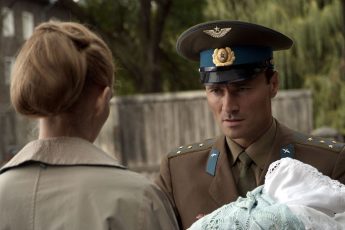Show Business
Mike Lerner and Maxim Pozdorovkin’s Pussy Riot: A Punk Prayer (2013)
Vol. 36 (December 2013) by Colette de Castro
Pussy Riot: A Punk Prayer scrutinizes the famous performance art piece which took place in February 2012, and for which the two women were sentenced to two years of imprisonment. What show could cause such controversy? Five members of the punk band Pussy Riot, wearing brightly colored balaclavas and sleeveless dresses, performed a punk song on the altar of Christ the Savior Cathedral in Moscow. The film follows the long trial and eventual condemnation of three of these female performers in August 2012.
Performing at an altar was a calculated choice. The group are self-proclaimed feminists and critics of Putin’s regime: they got together the day Putin came back into power in 2011. Near the beginning of the documentary, Nadia, a 22 year-old member of the group who participated in the performance, states that this spot was chosen because they believe women should be allowed to lead services in church. “A woman is not a sinful creature” she states, staring fiendishly at the camera. The first few minutes set the tone of the film. The girls are taken in for questioning one by one and the eldest, Katia, is grilled as to why she isn’t when she has children. She answers nonchalantly, but it’s clear from her reply that she is used to dealing with such old-fashioned ideology. A few frames later, a Twitter feed pops up at the bottom of the screen and we are plunged back into the 21st century. This struggle between the old and the new will be a constant theme.
The film is an in-depth look at a case much bigger than itself, one of feminism in Russia, and in which historical factors play a large part, beginning with the building where the performance was held. In the minds of Pussy Riot’s opponents the group’s actions call to mind the anti-clericalism of the Bolshevik revolution. One old woman who is protesting in the street against Pussy Riot remarks that they weren’t able to worship in the cathedral for 70 years. In 1931 it was dynamited at Stalin’s orders and replaced by a public swimming pool then rebuilt only in the 1990s. On the other hand, supporters of Pussy Riot compare the trial to a Soviet-era show trial, where it’s not actually the guilt of the defendant which is being judged, but rather it is a public demonstration of the political will of the government. These are also known as the Moscow trials, in which most of the surviving Old Bolsheviks were charged with conspiring with Western powers to assassinate Stalin and other Soviet leaders.
If it is one, what a show trial it is… during the court scenes, the three accused, Nadia, Masha and Katia, are made to sit or stand in a shared padlocked cage made of glass and wood. There is something distinctly Shakespearean about this courtroom layout as they prepare for their final monologues. Three beautiful young woman locked in a glass box, like bewildering objects in a curiosity museum. They speak confidently to the media, family members come to the edge of the box excitedly to share the latest news. One of the woman’s lawyers informs them that Madonna revealed the words ‘Pussy Riot’, on her back during a concert, and they nod politely, accepting the fact as if they were lawyers themselves. Nadia boldly tells one camera: “If you are intelligent then you can survive prison”.
Nadia, the youngest, is clearly the leader of the group. Her eccentric father is prominent in the film. In a oversized sweater, and looking rather dishevelled, he proudly leads the camera to the location of the first Pussy Riot gig, quietly adding that he was the one who suggested the lyrics “God, shit”, to Nadia. This became the chorus of the protest song the girls sang in the Cathedral, which in turn led to their eventual incarceration. Stanislav, Katia’s father, is rather more doubtful about the performance. He quotes himself ticking his daughter off “Keep your strange beliefs to yourselves”. Katia is probably the most excited of the girls, she is also the one who eventually manages to evade the charges in the end, despite a short period in jail. The other girls, who both have young children, are more subdued. Their steadfast calm and refusal to apologize is perhaps, and this is suggested throughout the film, what made many Russian citizens unable to sympathize with their cause.
Though the study of the girls themselves is interesting, the glimpses into the other side of the story are even more intriguing. The documentary takes us into the headquarters of the ‘Carriers of the Cross’, where tall, powerful looking gray-bearded men whose T-shirts read “Orthodoxy or Death” and who literally carry around huge wooden crosses, which they call their spiritual weapons, explain how the girls are ‘demonic’. One of them says very seriously that “there is a plan of action in place, to destroy both Church and State” – a statement with which Pussy Riot members may well be inclined to agree. In the car, once again with the cross carriers, they state, “In the 16th century they would have hanged them, they would have burned them” and a bit further on one old man says, “The main one, she’s a demon with a brain, she’s stubborn…there have always been witches who won’t repent.” Another carrier of the cross announces that she is a “witch”, and a “real modern demon”, because of ‘her eyes and her lips’.
Nadia, the so-called “demon with a brain”, declares in another scene during her defense that she and her group are nothing but “jokers, jesters, holy fools”. As in medieval times in Western Europe, the female sex is demonized by the designation ‘Witch’.
This connection between the girls and demons is one found in nearly every opposition argument we come across. On a television talk-show, one presenter states, “These are real demons, real revolutionaries”. The filmmakers don’t try to hide their appearance: especially the two who end up in jail. Nadia with her perfect skin and dark, clever eyes; Masha with her long, wild curly hair and her big black jacket. These appearances are rather unorthodox and could be interpreted this way. Whether or not this is an image the girls choose to perpetuate is not clear. Indeed, some feminists grieve the loss of belief in the real witch, seeing the witch as a nonconforming figure who threatened established sex/gender systems.
The characters – this is a documentary and the opening credits announce the names of the three girls as “stars” – all have distinctly different personalities. Before the final defense, we are presented with their personal histories through their past political actions. Katia’s famous ‘kissing a police officer’ sketch, Nadia’s live sex performance in the National history museum, and Masha’s environmental activism. Performance art is therefore not unheard of in Russia, but as one man explains, it remains distinctly unusual and hardly understood. One may have trouble convincing a modern Western viewer that performance art is demonic as such, especially those who have been exposed to radical works of art such as Yoko Ono’s “Cut Piece” in 2003, or anything at all by Marina Abramovic.
During the trial, the girls are asked to defend themselves one by one, and their speeches resemble the final pleas of Shakespeare’s condemned heroines. When Masha speaks: “For me, this trial is a ‘so-called trial’… and you can only deprive me of my ‘so-called freedom’”, she still seems to be making a final plea. Reminiscent of Joan of Arc’s final speech in Henry VI, which begins “Now let me tell you whom you have condemned”; each girl justifies her own case with a detailed analysis of the political situation to which she is reacting. When Nadia begins her speech with the words “the three members of Pussy Riot are not the ones on trial here”, it seems to come straight from Joan of Arc’s virginal mouth, who said: “Because you want the grace that others have/You judge it straight a thing impossible/To compass wonders but by help of devils/No, misconceived!” Applause breaks out after Masha’s defense speech and the judge quickly reprimands them: “This is a court, not a theatre”. But there is a fine line between the two in this mise en scène. Every girl’s final speech is a work of art and a final eloquent plea.
During their closing argument, Pussy Riot’s defense attorneys point out the brevity of the performance in the Cathedral – in total it lasted for 30 seconds – and its undoubtedly sloppy organization. It is certainly true that at the beginning of the film they were far more ‘Femen’ than Joan of Arc. The irony of the situation is that the girls become more and more eloquent throughout the trial, until at their final ‘performance’ they manage to articulate their ideas, clearly refined through many hours of thought, discussion and international contribution. This so-called show trial gave them a real stage where they could again pronounce their punk prayer.




Leave a Comment